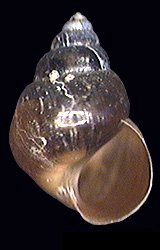Biology:Assiminea grayana
| Assiminea grayana | |
|---|---|

| |
| Scientific classification | |
| Domain: | Eukaryota |
| Kingdom: | Animalia |
| Phylum: | Mollusca |
| Class: | Gastropoda |
| Subclass: | Caenogastropoda |
| Order: | Littorinimorpha |
| Family: | Assimineidae |
| Genus: | Assiminea |
| Species: | A. grayana
|
| Binomial name | |
| Assiminea grayana Fleming, 1828
| |
Assiminea grayana, common name the "dun sentinel", is a species of very small (4–6 mm.) salt marsh snail, a terrestrial (or marine gastropod mollusk in the family Assimineidae.
Habitat
This species lives in habitats that are intermediate between land and saltwater: in estuaries and salt marshes, at, or right above, the high tide level.[1]
Description
The 5 mm high x 3 mm. wide shell is semi-transparent and conical, with six or seven flat-sided or slightly swollen whorls and a sharp apex. It bears fine irregular growth lines and faint spiral lines but appears smooth . The oval or ear-shaped aperture is small and has a thickened peristome. The inner lip is reflexed over the base of the last whorl. There is no umbilicus. The colour is horn or tan, often with a broad reddish band on the last whorl.
Distribution
This small snail lives in Western Europe, primarily on the southern part of the North Sea coasts, in countries and islands including:
- Great Britain
- Ireland
- The Netherlands
Reproduction
This species reproduces sexually. The male has a penis in the middle, or at least close to the middle, of his head. The female has a series of translucent glands the lead to a seminal receptacle, where an egg waits for the semen.[2]
References
- ↑ Kerney, Michael, 1999, Atlas of the land and freshwater molluscs of Britain and Ireland, Harley Books, Colchester, England, ISBN:0-946589-48-8.
- ↑ Hallan, Anders, et al. “Two New Species of OvassimineaThiele, 1927 (Truncatelloidea: Assimineidae) from Tropical Australia.” Molluscan Research, vol. 35, no. 4, 2015, pp. 262–274., doi:10.1080/13235818.2015.1053171.
External links
- Assiminea grayana at Animalbase
- Assiminea grayana Species account and photograph at Mollusc Ireland.
Wikidata ☰ Q3172385 entry
 |


